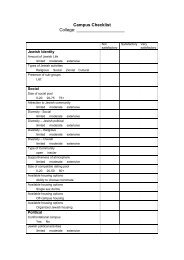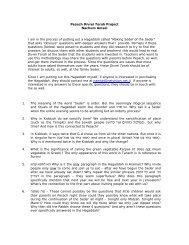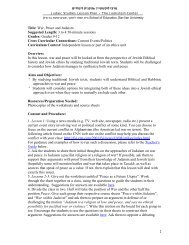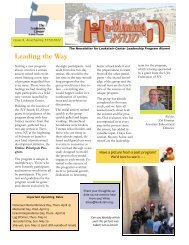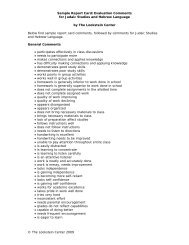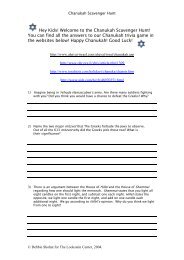(f) After an infinitive used for emphasis. In such a case, even <strong>the</strong> infinitive does not always take a vav. Summary The first word in a clause must (normally) have a vav attached, even at <strong>the</strong> beginning <strong>of</strong> a book (e.g. Ruth, Es<strong>the</strong>r). If <strong>the</strong> first word <strong>of</strong> <strong>the</strong> clause happens (as in most cases) to be a verb in <strong>the</strong> perfective or imperfective, <strong>the</strong> vav becomes conversive, so to get an imperfective meaning you must use a perfective verb with <strong>the</strong> conversive vav, and vice-versa.
Chapter 7 FORMING THE TENSES Now we can continue from where we left <strong>of</strong>f in chapter 5, and show how Hebrew tenses are formed. First <strong>the</strong> simple tenses An ordinary past tense I ate (aorist, preterite or what you will) is expressed by <strong>the</strong> perfective alone, or by <strong>the</strong> imperfective with a conversive vav, and <strong>the</strong> subject, if any, follows <strong>the</strong> verb. וַיִּכְבַּד לֵב פַּרְעֹה וְלֹא שָׁ מַע פַּרְעֹה An ordinary future tense I will eat is expressed by <strong>the</strong> imperfective alone, or by <strong>the</strong> perfective with a conversive vav, and <strong>the</strong> subject, if any, usually follows <strong>the</strong> verb. וְשָׁ רַץ הַיְאֹר צְפַרְדְּעִים זֶרַע רַב תּוֹצִיא הַשָּׂ דֶה This is not too difficult. Next <strong>the</strong> repeat tenses The usual way <strong>of</strong> expressing repeated action - I used to eat, I eat, I will (more than once) eat is by <strong>the</strong> imperfective alone or <strong>the</strong> perfective with conversive vav, exactly as <strong>the</strong> simple future, except that <strong>the</strong> repeated action need not be in <strong>the</strong> future. Again, <strong>the</strong> subject, if any, follows <strong>the</strong> verb. וְהָיָה כַּאֲשֶׁ ר יָרִים מֹשֶׁ ה יָדוֹ וְגָבַר יִשְׂ רָאֵל Three verbs in a row all expressing repeated action in <strong>the</strong> past. For a repeated action in <strong>the</strong> present, optionally <strong>the</strong> participle may be used, as <strong>of</strong>ten in <strong>the</strong> Psalms. illustrates both methods. מֵקִים מֵעָפָר דָּל, מֵאַשְׁ פֹּת יָרִים אֶבְיוֹן Then <strong>the</strong> relative tenses For a completed action I had eaten, I have eaten, I will have eaten (perfect, pluperfect and future- perfect tenses), <strong>the</strong> perfective is used, with <strong>the</strong> subject preceding <strong>the</strong> verb - <strong>the</strong>re must be one. What counts is <strong>the</strong> relative time <strong>of</strong> <strong>the</strong> action - <strong>the</strong> background time is irrelevant. Abimelech had not approached her In <strong>the</strong> following, for comparison, we have used (invented) negative verbs to avoid <strong>the</strong> complications <strong>of</strong> <strong>the</strong> conversive vav. Compare Moses did not eat <strong>the</strong> meat Moses had not eaten <strong>the</strong> meat He did not eat <strong>the</strong> meat He had not eaten <strong>the</strong> meat Note <strong>the</strong> need in <strong>the</strong> last example to insert a pronoun, to distinguish it from <strong>the</strong> previous one. For an example <strong>of</strong>a future perfect, we find in Lev. 9 :4 ‘will have appeared’ וַאֲבִימֶלֶךְ לֹא קָרַב אֵלֶיהָ וְלֹא אָכַל מֹשֶׁ ה אֶת הַבָּשָׂ ר וּ מֹשֶׁ ה לֹא אָכַל אֶת הַבָּשָׂ ר וְלֹא אָכַל אֶת הַבָּשָׂ ר וְהוּא לֹא אָכַל אֶת הַבָּשָׂ ר ה ‘ נִרְאָה אֲלֵיכֶם For an action not yet commenced, one about to take place (<strong>the</strong> ‘intended’) I was about to eat, I am about to eat, I will be about to eat <strong>the</strong> background time does matter. If it is in <strong>the</strong> past I was about to eat, <strong>the</strong> imperfective is used, with <strong>the</strong> subject before <strong>the</strong> verb, and generally also .טֶרֶם When this extra word is used, <strong>the</strong>y were not always too fussy about putting in a pronoun to make sure that <strong>the</strong>re is a subject (as with <strong>the</strong> perfect above). They were about to lie down: .טֶרֶם יִשְׁ כָּבוּ but Gen. 19:4 just וְהֵמָּה טֶרֶם יִשְׁ כָּבוּן Jos. 2:8 A word about .טֶרֶם It means ‘yet’ or ‘still’, and is only used in a context such as this. ‘They were yet about to lie down.’ In English we say ‘<strong>the</strong>y had NOT yet lain down’, <strong>the</strong> reason being that we also change <strong>the</strong> tense, and use a past instead <strong>of</strong> a future. It is not correct to translate טֶרֶם as ‘not yet’, it means ‘yet’. However, when we translate <strong>the</strong> entire clause, we may change <strong>the</strong> tense and use ‘not yet’. When <strong>the</strong> time is <strong>the</strong> present, and we are dealing with an intended action I am about to eat, an alternative is to use הִנֵּה followed by <strong>the</strong> subject and <strong>the</strong>n <strong>the</strong> participle. This is why in Ex. 9:3 <strong>the</strong> present participle <strong>of</strong> <strong>the</strong> verb ‘to be’ has to be used: G-d's arm is about to be against your livestock ‘ Without <strong>the</strong> participle, ‘ would be a description <strong>of</strong> an existing state <strong>of</strong> affairs, that <strong>the</strong> livestock was already being attacked, not that it was about to be attacked. הִנֵּה יַד ה הוֹיָה בְּמִקְנְךָ הִנֵּה יַד ה בְּמִקְנְךָ



